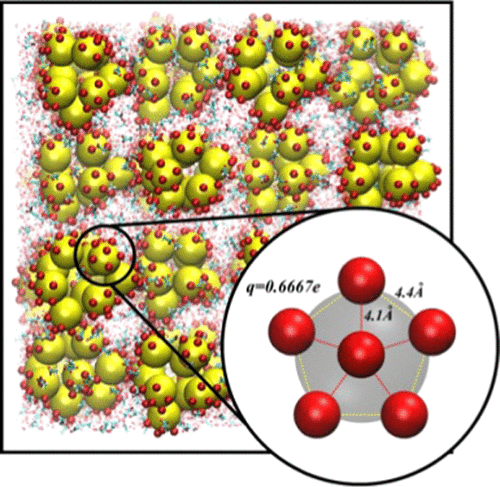当前位置:
X-MOL 学术
›
J. Phys. Chem. B
›
论文详情
Our official English website, www.x-mol.net, welcomes your feedback! (Note: you will need to create a separate account there.)
Cluster Crystals Stabilized by Hydrophobic and Electrostatic Interactions
The Journal of Physical Chemistry B ( IF 3.3 ) Pub Date : 2018-02-12 00:00:00 , DOI: 10.1021/acs.jpcb.7b11662 A. Baumketner 1 , A. Stelmakh 2 , W. Cai 3
The Journal of Physical Chemistry B ( IF 3.3 ) Pub Date : 2018-02-12 00:00:00 , DOI: 10.1021/acs.jpcb.7b11662 A. Baumketner 1 , A. Stelmakh 2 , W. Cai 3
Affiliation

|
Cluster crystals are crystalline materials in which each site is occupied by multiple identical particles, atoms, colloids, or polymers. There are two classes of systems that make cluster crystals. One is composed of particles that interact via potentials that are bound at the origin and thus are able to penetrate each other. The other consists of non-interpenetrating particles whose interaction potential diverges at the origin. The goal of this work is to find which systems of the second class can make cluster crystals that are stable at room temperature. First, the general properties of the required potentials are established using an analytical model and Monte Carlo simulations. Next, we ask how such potentials can be constructed by combining hydrophobic attraction and electrostatic repulsion. A colloid model with a hard-sphere core and a repulsive wall is introduced to mimic the hydrophobic interaction. Charge is added to create long-range repulsion. A search in the parameter space of the colloid size, counterion type, and charge configuration uncovers several models for which effective colloid–colloid interaction, determined in explicit solvent as a potential of mean force, has the necessary shape. For the effective potential, cluster crystals are confirmed as low free-energy configurations in replica-exchange molecular dynamics simulations, which also generate the respective transition temperature. The model that exhibits a transition above room temperature is further studied in explicit solvent. Simulations on a 10 ns time scale show that crystalline conformations are stable below the target temperature but disintegrate rapidly above it, supporting the idea that hydrophobic and electrostatic interactions are sufficient to induce an assembly of cluster crystals. Finally, we discuss which physical systems are good candidates for experimental observations of cluster crystals.
中文翻译:

通过疏水和静电相互作用稳定的团簇晶体
团簇晶体是晶体材料,其中每个位点都被多个相同的粒子,原子,胶体或聚合物占据。有两类系统可以制造团簇晶体。一个由粒子组成,这些粒子通过在原点绑定的电势相互作用,因此能够相互穿透。另一个由非互穿颗粒组成,其相互作用势在起点处发散。这项工作的目的是找到第二类的哪些系统可以制造在室温下稳定的簇状晶体。首先,使用分析模型和蒙特卡洛模拟来建立所需电势的一般属性。接下来,我们问如何通过结合疏水吸引和静电排斥来构建这样的电势。引入具有硬球核和排斥壁的胶体模型来模拟疏水相互作用。添加电荷会产生远距离排斥。在胶体大小,抗衡离子类型和电荷构型的参数空间中进行搜索后,发现了几种模型,这些模型的有效胶体-胶体相互作用(在显式溶剂中确定为平均力的势能)具有必要的形状。为了获得有效电势,在复制-交换分子动力学模拟中,团簇晶体被确认为低自由能构型,这也产生了各自的转变温度。在显性溶剂中进一步研究了表现出高于室温的转变的模型。在10 ns时间尺度上的仿真表明,在目标温度以下,晶体构型稳定,但在目标温度以下会迅速崩解,这证明了疏水和静电相互作用足以诱导簇状晶体组装的想法。最后,我们讨论了哪些物理系统是团簇晶体实验观察的良好候选者。
更新日期:2018-02-12
中文翻译:

通过疏水和静电相互作用稳定的团簇晶体
团簇晶体是晶体材料,其中每个位点都被多个相同的粒子,原子,胶体或聚合物占据。有两类系统可以制造团簇晶体。一个由粒子组成,这些粒子通过在原点绑定的电势相互作用,因此能够相互穿透。另一个由非互穿颗粒组成,其相互作用势在起点处发散。这项工作的目的是找到第二类的哪些系统可以制造在室温下稳定的簇状晶体。首先,使用分析模型和蒙特卡洛模拟来建立所需电势的一般属性。接下来,我们问如何通过结合疏水吸引和静电排斥来构建这样的电势。引入具有硬球核和排斥壁的胶体模型来模拟疏水相互作用。添加电荷会产生远距离排斥。在胶体大小,抗衡离子类型和电荷构型的参数空间中进行搜索后,发现了几种模型,这些模型的有效胶体-胶体相互作用(在显式溶剂中确定为平均力的势能)具有必要的形状。为了获得有效电势,在复制-交换分子动力学模拟中,团簇晶体被确认为低自由能构型,这也产生了各自的转变温度。在显性溶剂中进一步研究了表现出高于室温的转变的模型。在10 ns时间尺度上的仿真表明,在目标温度以下,晶体构型稳定,但在目标温度以下会迅速崩解,这证明了疏水和静电相互作用足以诱导簇状晶体组装的想法。最后,我们讨论了哪些物理系统是团簇晶体实验观察的良好候选者。


























 京公网安备 11010802027423号
京公网安备 11010802027423号